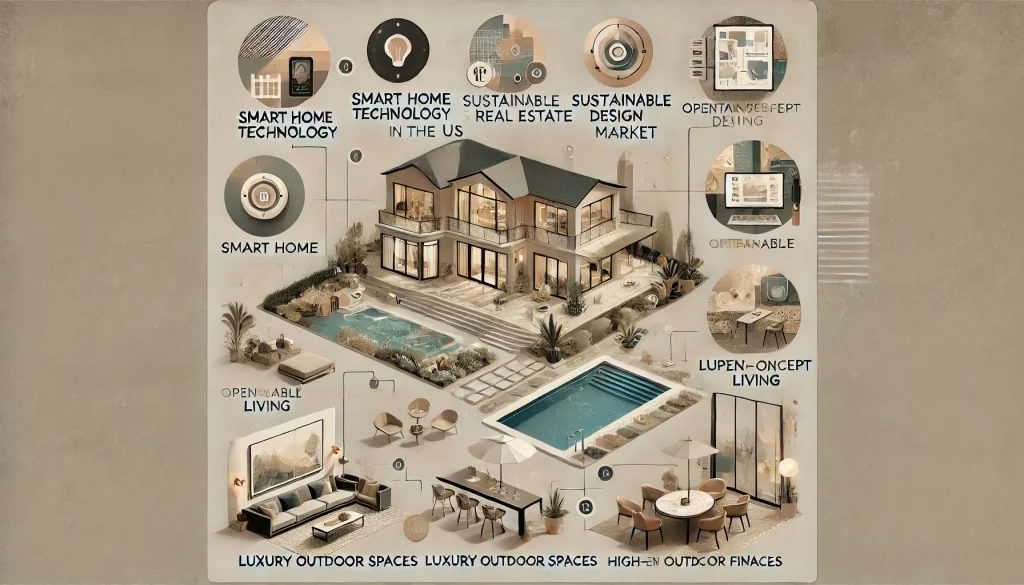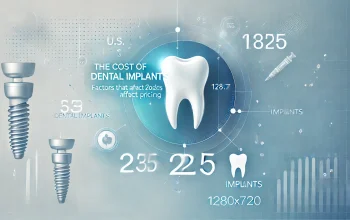Innovative Luxury Home Features Transforming the US Real Estate Market

In recent years, luxury home design in the United States has evolved rapidly to accommodate changing tastes, lifestyle preferences, and technological innovations. The ultra-high-net-worth individuals (UHNWIs) who purchase these opulent properties expect their homes to not only offer comfort and style but also provide the latest amenities, technologies, and eco-conscious designs. In 2024 and beyond, several luxury home design trends are defining the landscape of the US real estate market, reflecting both the changing desires of homeowners and the ongoing shifts in architecture, sustainability, and tech integration.
Table of Contents
1. Sustainable and Eco-Friendly Design
One of the most notable trends in luxury home design is a growing emphasis on sustainability. As climate change and environmental concerns take center stage, luxury homeowners are increasingly looking for homes that are eco-conscious, energy-efficient, and designed with sustainability in mind.
a. Energy-Efficient Features
Green energy solutions such as solar panels, geothermal heating systems, and energy-efficient windows are becoming standard in high-end homes. Homeowners are seeking to reduce their carbon footprint while still maintaining the luxurious features they desire. Some properties even include Tesla Powerwalls or other battery storage systems to ensure energy independence and sustainability.
b. Sustainable Materials
The use of sustainable and recycled building materials is another key feature of luxury homes in 2024. Bamboo flooring, reclaimed wood, and recycled steel are popular choices, not only for their eco-friendly properties but also for the rustic, modern aesthetic they bring to home design. Furthermore, eco-friendly insulation materials such as sheep’s wool or recycled denim are being used in many luxury properties.
c. Water Conservation Technologies
Water-saving fixtures, rainwater harvesting systems, and greywater recycling systems are becoming more common in luxury homes, especially in drought-prone areas like California. Homeowners are also opting for native landscaping to reduce water usage, integrating xeriscaping techniques with beautiful designs that require minimal irrigation.
2. Smart Homes and Advanced Technology
The integration of smart home technology is no longer an added luxury but an expectation for high-end properties. Modern luxury homes are equipped with cutting-edge tech solutions that simplify daily living and offer unparalleled convenience.
a. Home Automation Systems
From lighting and climate control to security and entertainment systems, home automation is transforming how homeowners interact with their properties. Voice-activated assistants like Alexa and Google Home are integrated into the home’s infrastructure, allowing residents to control nearly every aspect of their environment with a simple voice command.
b. Health Monitoring and Wellness Tech
An emerging trend is the incorporation of health and wellness technologies. Smart mirrors that can track health metrics such as heart rate and weight are becoming a staple in luxury home gyms and bathrooms. Air quality monitoring systems and advanced HVAC units with air filtration technology are also being installed to ensure optimal indoor air quality.
c. Security and Privacy Features
Advanced security systems that include biometric recognition, facial identification, and AI-driven surveillance systems are increasingly in demand. Many luxury homeowners prioritize privacy and security, opting for features like invisible fences, panic rooms, and high-tech surveillance drones.
3. Indoor-Outdoor Living Spaces
Seamlessly blending indoor and outdoor spaces has become a hallmark of luxury home design. The trend is driven by a desire to maximize natural light, embrace outdoor living, and create multifunctional spaces that blur the lines between the inside and outside of the home.
a. Expansive Glass Walls and Sliding Doors
Floor-to-ceiling glass walls and sliding doors that open onto patios, pools, and gardens are common features in contemporary luxury homes. These designs allow for an abundance of natural light while providing unobstructed views of the surrounding landscape.
b. Outdoor Kitchens and Entertainment Areas
High-end outdoor kitchens equipped with professional-grade appliances, pizza ovens, and built-in grills are popular among homeowners who enjoy entertaining. These outdoor spaces often feature luxurious touches such as fire pits, infinity pools, and rooftop terraces with breathtaking views.
c. Landscaping as Art
Luxury homeowners are increasingly treating their outdoor spaces as extensions of the home’s interior design. Beautifully landscaped gardens, complete with sculptures, water features, and manicured lawns, are being designed to complement the home’s architecture and offer a peaceful retreat from daily life.
4. Spa-Like Amenities and Wellness-Focused Features
Health and wellness are major considerations for today’s luxury homebuyers. As a result, homes are being designed with features that promote relaxation, mental well-being, and physical health.
a. Home Spas and Saunas
Luxury homes now frequently come equipped with spa-like bathrooms that feature steam showers, saunas, and even massage rooms. Homeowners are incorporating elements like Himalayan salt walls, aromatherapy systems, and custom-built soaking tubs to create a personal oasis within their homes.
b. Home Gyms and Fitness Studios
Dedicated fitness spaces are becoming more sophisticated, with homes featuring fully equipped gyms, yoga studios, and even virtual reality workout rooms. Wellness rooms that support meditation and relaxation are also trending, with design elements such as soft lighting, soothing sounds, and calming color palettes.
c. Indoor Pools and Cold Plunge Pools
Indoor swimming pools, cold plunge pools, and hydrotherapy tubs are growing in popularity among luxury homeowners who prioritize health and wellness. These features provide a year-round space for fitness and relaxation, regardless of the climate outside.
5. Personalized and Custom Designs
Customization is key in luxury real estate. Today’s affluent buyers are looking for homes that reflect their personal tastes and lifestyle, often working closely with architects and designers to create one-of-a-kind living spaces.
a. Bespoke Interiors
High-net-worth individuals are seeking out homes with custom-designed interiors that reflect their personalities. This may include one-of-a-kind art installations, handcrafted furniture, and unique architectural details. Homes are being personalized to suit the specific preferences of the owners, whether that means a wine cellar with a tasting room, a private movie theater, or a cigar lounge.
b. Artisan Craftsmanship
The trend toward artisanal, handcrafted elements continues to grow in luxury home design. From hand-carved woodwork to custom metal accents, homes are showcasing the craftsmanship of skilled artisans. This level of attention to detail adds a layer of exclusivity and uniqueness to each property.
c. Multi-Purpose Rooms
With the rise of remote work and homeschooling, multi-functional spaces are becoming a necessity in luxury homes. Custom-built offices, libraries, and study areas are designed to provide functional workspaces while maintaining the elegance and comfort of a luxury home. Flex spaces that can easily transition from a home office to a guest room or a playroom are increasingly popular.
6. Minimalist and Modern Aesthetics
A shift toward minimalism and clean, modern design is shaping the look and feel of luxury homes in the US. Homeowners are drawn to sleek lines, open floor plans, and neutral color schemes that create a sense of spaciousness and tranquility.
a. Open Concept Living
The trend of open concept living, where the kitchen, dining, and living areas flow into one another, continues to dominate luxury home design. This layout encourages a sense of connection and ease, making homes feel larger and more inviting.
b. Neutral Palettes with Natural Materials
The use of neutral color palettes, combined with natural materials such as stone, wood, and glass, is popular in modern luxury homes. These design elements bring a sense of calm and serenity, allowing the home’s architectural features and furnishings to stand out without overwhelming the space.
c. Smart Lighting and Mood Control
Lighting plays a crucial role in setting the ambiance of a luxury home. Smart lighting systems that can be controlled via smartphone or voice command are being used to adjust the intensity and color of lights throughout the day. These systems are often integrated with automated blinds or curtains to control the amount of natural light entering the home, creating a dynamic and responsive living environment.
7. Location-Specific Design
Location plays a significant role in shaping the design of luxury homes. Whether it’s a beachfront estate, a mountain retreat, or an urban penthouse, luxury homes are being tailored to complement their surroundings.
a. Oceanfront and Waterfront Homes
Homes on the coast or near bodies of water are designed to maximize views, with large windows, expansive decks, and outdoor living spaces that capitalize on the natural beauty of the surroundings. Features like private docks, infinity pools that blend into the horizon, and beachfront access are highly desirable in these properties.
b. Mountain Retreats
In regions like Colorado, luxury homes are being built with rustic, chalet-inspired designs that integrate stone and wood to blend seamlessly into the mountain landscape. Cozy fireplaces, floor-to-ceiling windows with panoramic views, and ski-in, ski-out access are common features of these homes.
c. Urban Penthouses
For those seeking city living, urban penthouses offer the pinnacle of luxury. These properties often include expansive terraces, high-end finishes, and private elevators, offering a serene escape from the hustle and bustle of city life. With stunning skyline views and proximity to cultural amenities, urban penthouses are a favorite among affluent buyers.
8. Sustainability Beyond Energy Efficiency
Beyond energy-efficient appliances and solar panels, sustainability in luxury home design is taking on broader dimensions. Luxury homes are increasingly incorporating features that promote sustainable living at every level of design, construction, and habitation.
a. LEED-Certified and Passive House Design
More luxury homes are seeking LEED certification or adopting Passive House principles, which focus on airtight, well-insulated homes that require minimal energy for heating and cooling. These homes are designed with sustainability at their core, utilizing environmentally friendly building materials and focusing on long-term energy savings.
b. Local Sourcing and Low-Impact Construction
High-end homeowners are becoming more conscious of where their materials come from. Locally sourced stone, reclaimed wood, and low-impact construction techniques are gaining popularity. Builders are focusing on reducing waste and ensuring that their methods have as little
environmental impact as possible.
Conclusion
The luxury home design landscape in the US is constantly evolving to meet the demands of a discerning and affluent clientele. In 2024, sustainability, cutting-edge technology, wellness-focused amenities, and personalized, location-specific designs dominate the market. The integration of smart systems, eco-friendly features, and bespoke craftsmanship ensures that today’s luxury homes are not just opulent but also designed to enhance the quality of life, offering a seamless blend of comfort, innovation, and style. As trends continue to shift, luxury homes will remain at the forefront of architectural and technological innovation, setting the standard for what it means to live a life of true luxury.



1 thought on “Innovative Luxury Home Features Transforming the US Real Estate Market”